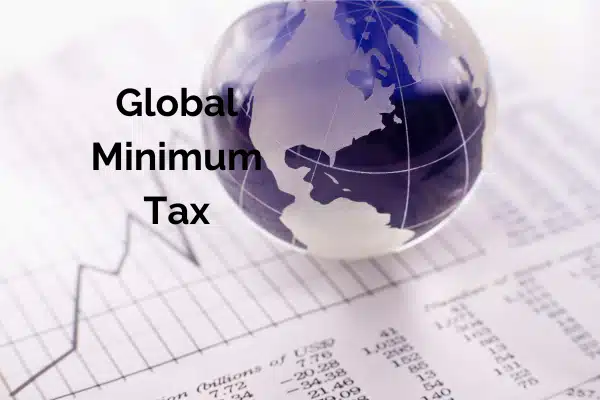Everything you need to know about Global Minimum Tax and its application
The evolution of international taxation has taken a major turn with the introduction of the Global Minimum Tax. This measure aims to combat tax evasion by multinational companies and ensure a fairer distribution of tax revenues worldwide. In this article, we explore in detail what the Global Minimum Tax is, why it was introduced, and how companies can prepare for its application.
What is the Global Minimum Tax ?
The Global Minimum Tax is a worldwide tax measure that imposes a minimum tax rate on multinationals, regardless of where they operate. The aim is to prevent companies from artificially shifting their profits to low-tax jurisdictions in order to reduce their tax burden.
Origins and background
The initiative comes from theOrganisation for Economic Co-operation and Development (OECD), which has launched an ambitious plan known as the BEPS Project (Base Erosion and Profit Shifting). The plan aims to tackle the aggressive tax practices of companies that exploit loopholes in the international tax system to shift profits to tax havens.
Main objectives
- Reduce tax evasion: Ensure that companies pay their fair share of taxes in the countries where they actually operate.
- Create a level playing field: prevent certain companies from benefiting from favorable tax regimes, to the detriment of others.
- Increase tax revenues: enable countries to raise more funds to finance their infrastructure and public services.
The international agreement
By 2021, more than 130 countries, representing over 90% of global GDP, have signed the OECD agreement on minimum taxation. This commitment marked a significant step towards global tax harmonization, demonstrating a collective will to combat tax base erosion.
How does Global Minimum Tax work ?
The basic principle
The Global Minimum Tax imposes an overall minimum tax rate of 15% on the profits of large multinational companies, irrespective of the jurisdiction in which they make those profits. If a company pays less than this rate in one country, its parent company will be obliged to pay an additional tax to reach the 15% threshold.
Application criteria
This measure mainly applies to companies with annual sales in excess of €750 million. This threshold ensures that only large multinationals are subject to this rule, thus limiting the impact on small and medium-sized businesses.
Calculation method
The tax authorities will use complex formulas to determine the effective tax rate applied to the profits of each of the company’s subsidiaries worldwide. If this rate is below 15%, the difference will have to be paid by the parent company in its country of tax residence.
A concrete example
Let’s take a fictitious multinational company, “GlobalTech Inc.”, which has subsidiaries in several countries, some of which offer very low tax rates. Let’s assume that the subsidiary based in a low-tax country posts a profit of 100 million euros and is taxed at a rate of 5%. The parent company, located in an OECD country, would have to pay an additional 10% tax (i.e. 10 million euros) to reach the 15% rate imposed by the Global Minimum Tax.
Why is this measure necessary ?
Tax evasion: a persistent problem
Large corporations often resort to complex practices to minimize their tax burden. This includes the use of tax havens, where tax rates are very low or non-existent. This practice deprives governments of essential tax revenues and creates an uneven playing field for local companies.
According to a study carried out by the OECD, profit-shifting strategies account for annual tax revenue losses of between $100 and $240 billion, or around 4% to 10% of corporate tax revenues. This figure demonstrates the scale of the challenge facing the international community in ensuring fair taxation.
A positive global impact
According to the OECD, the application of a global minimum tax could generate over $150 billion in additional tax revenues each year. These funds can be reinvested in key sectors such as health, education and infrastructure, contributing to global economic development.
The introduction of this minimum tax also aims to restore public confidence in the tax system. By showing that large corporations pay their fair share, governments can improve citizens’ perception of tax fairness.
What are the challenges and implications for businesses ?
Compliance and adaptation
One of the main concerns for multinationals is to understand how this new rule will affect their tax structures. To comply with the Global Minimum Tax, companies need to:
- Adapt their tax strategies: Reassess the use of subsidiaries in low-tax jurisdictions.
- Strengthen their financial reporting processes: Ensure greater transparency and accuracy in calculating effective tax rates.
- Invest in technology solutions: Use tax management software, such as CCH Tagetik, to manage and automate international tax calculations.
Impact on competitiveness
Some companies may find that this new minimum rate reduces their competitiveness, particularly if they are used to advantageous tax regimes. It is essential to review business models and explore other ways of remaining competitive without relying solely on tax advantages.
Impact by sector
- Technology: Technology companies, which often have subsidiaries in numerous countries, will have to review their tax practices and value chains.
- Pharmaceuticals: This industry, which frequently uses sophisticated tax structures to minimize taxes, will be particularly affected by the new rules.
- Finance: Banks and financial institutions will need to implement transparent and accurate reporting processes to comply with the new regulations.
Preparing for change
Case studies
- The case of Meta Platforms (formerly Facebook): Meta, which has long been criticized for its tax practices, has already begun to review its structure to adapt to the new global tax realities.
- Apple Inc: With a global presence and assets in several low-tax jurisdictions, Apple will probably have to adjust its tax strategy.
Risks of non-compliance
Failure to comply with global minimum tax rules can result in severe sanctions, financial penalties and increased audits. It is therefore crucial for companies to comply with the requirements and take a proactive approach to tax management.
How to prepare for the application of the Global Minimum Tax ?
1. Assess the financial impact
Companies need to carry out a comprehensive assessment of the financial impact of the minimum tax rule. This includes analyzing subsidiaries in low-tax jurisdictions and modeling potential additional costs.
Example of a detailed calculation
To assess the impact, companies need to create detailed financial models taking into account the profits made in each jurisdiction, current tax rates and the adjustments needed to reach the minimum rate.
2. Strengthen regulatory compliance
Adopting advanced tax compliance and reporting tools can ease the transition. Solutions like CCH Tagetik offer integration capabilities to calculate and report taxes efficiently, ensuring that companies comply with new tax requirements.
Benefits of using technology
- Automated calculations: Technology reduces human error and ensures accurate tax reporting.
- Centralized management: Integrated platforms enable global tax data to be centralized, facilitating transparency and compliance.
3. Train internal teams
It is crucial to train finance and tax teams so that they are aware of the new rules and understand how to apply them. This can include training on international accounting standards and the implications of the OECD’s BEPS Project.
The future of the Global Minimum Tax
Towards greater cooperation
The Global Minimum Tax is the first step towards greater international tax cooperation. Countries will need to continue working together to refine the rules and ensure that application is uniform and fair. This cooperation could also lead to new initiatives to further harmonize international tax practices.
Adapting to new economic realities
As the global economy evolves, notably with the rise of digital commerce and data-driven business models, tax rules will need to adapt. Experts predict that further adjustments will be necessary to meet the challenges posed by emerging technologies and increasingly complex supply chains.
Conclusion
The Global Minimum Tax represents a significant step towards better regulation of multinational tax practices. While implementation of this rule may present challenges for some companies, preparation and proactive adaptation will enable organizations to minimize disruption while complying with the new tax standards. If properly implemented, this measure will contribute to a fairer tax environment and greater economic stability worldwide.
To make this transition a success and ensure optimum compliance, companies can rely on advanced technological tools. CCH Tagetik is positioned as a comprehensive solution enabling organizations to manage the growing complexity of international tax regulations. This solution helps automate the complex calculations required for compliance, while centralizing and harmonizing global financial and tax data. It improves transparency and reporting accuracy through integrated reporting processes.
Adopting CCH Tagetik gives companies the flexibility and security they need to adapt effectively to the requirements of this Tax while strengthening their global compliance strategy. In addition to guaranteeing compliance with new tax regulations, this solution will increase your company’s agility in the face of future regulatory changes.
Contact us today to find out how our CCH Tagetik solution can transform your approach to tax compliance and help you make a successful transition to the new international tax standards.

















